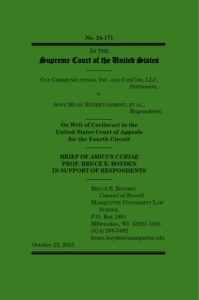Looking back at 2025 Developments in Wisconsin Water Law and Policy
2025 was a momentous year for water law and policy issues, both in Wisconsin and nationally. In this post, I focus mainly on some Wisconsin-specific developments and then summarize a few national-level issues.
Water use at data centers. The past year saw the emergence of widespread public concern over the environmental impacts of data centers—facilities that store and share vast amounts of data for the internet, artificial intelligence, cloud storage, and related applications and services, resulting in community opposition in some places. By most counts, Wisconsin is already home to more than 40 data centers, with several more in development. Data centers have become controversial because of their effects on the environment; perhaps most prominently, some use significant amounts of water for cooling their sensitive equipment (reportedly millions of gallons per day, in extreme cases). Other data centers have “closed loop” recycled water systems that use much less water but require increased electricity to operate. Of course, water and energy are closely connected – water is required to produce energy, and energy is required to treat and deliver clean water. This means that even those data centers that use recycled water systems have a sizable water footprint, considering the water used at the energy generating facility. Complicating the matter further, some data center developers have required host municipalities to sign nondisclosure agreements that purport to treat water use as a trade secret. Several proposed sites are facing backlash from surrounding communities.
PFAS rulemakings. The Wisconsin Department of Natural Resources (WDNR) is engaged in several rulemaking efforts related to per- and polyfluoroalkyl substances (PFAS). The term “PFAS” encompasses a broad range of chemical compounds, not a single substance. Since the 1950s, PFAS have been manufactured around the world and widely used in a broad array of products including food packaging, cosmetics, non-stick cookware, and firefighting foam. Prized for their durability and propensity to repel both oil and water, PFAS do not break down easily in the environment and have been tied to serious risks to human health. PFAS are commonly called “forever chemicals” because of the lack of degradation pathways.
WDNR’s ongoing regulatory efforts include setting limits for PFAS in groundwater (updates to Wisconsin Administrative Code Chapter NR 140), management of firefighting foam containing PFAS (updates to Chapter NR 159), and bringing Wisconsin drinking water rules for PFAS in line with federal standards (updates to Chapter NR 809). More information about these efforts can be found here on WDNR’s website.
Spills Law. The Wisconsin Supreme Court sided with the WDNR in a dispute over the extent of the agency’s authority to require responsible parties to clean up releases of PFAS and other emerging contaminants under the state’s “Spills Law,” Wis. Stat. s. 292.11. At its core, the Spills Law requires a person who causes the discharge of a “hazardous substance” (or who possesses or controls a hazardous substance that has been discharged) to notify WDNR of the spill and then to “take the actions necessary to restore the environment”—a potentially time-consuming and expensive process.
The central question in the case decided in June, Wisconsin Manufacturers and Commerce, Inc. et al. v. Wisconsin Natural Resources Board, et al., arose over whether WDNR could continue its historical practice of identifying “hazardous substances” on a case-by-case basis, or whether it had to engage in administrative rulemaking to create a list identifying which substances it considered hazardous, and at what quantities or concentrations in the environment. The rulemaking process is lengthy and often controversial, so a decision against DNR would have posed substantial challenges for it, potentially eliminating its ability to respond in real time to spills of emerging contaminants. On the other hand, a list of hazardous substances would provide predictability and certainty to parties responsible for cleanups under the Spills Law.
The supreme court held in DNR’s favor that the agency could continue its practice of determining whether a release involved a “hazardous substance” based on the individual circumstances of each case. The court held that the statute’s “broad and open-ended” definition of “hazardous substance” is cabined by the requirement that the substance significantly increase mortality or contribute to serious illness in humans, or that it may pose a substantial hazard to human health or the environment.
In considering how the Spills Law works, context is important, the court observed: “a gallon of milk spilled into Lake Michigan may not ‘pose a substantial present or potential hazard to human health or the environment,’ but a 500-gallon tank of beer or milk discharged into a trout stream might well pose [such a hazard] to the stream’s fish and environment.” Thus, the court thought it was critical for DNR to retain some flexibility in interpreting the statute.
Climate litigation and Wisconsin water resources. From constitutional claims that seek to reform the implementation of energy law in the state, to litigation over the federal government’s efforts to claw back funding for the development of renewable energy resources, Wisconsin has become increasingly involved with legal battles over the climate. Interestingly, one of the cases prominently invokes a constitutional doctrine connected to the state’s water resources – the public trust doctrine. Read more about these developments in one of my previous blog posts.
Aftermath of Evers v. Marklein II. This summer the Wisconsin Supreme Court issued its opinion in Evers v. Marklein II, striking down the authority to pause, object to, or suspend administrative rules held by the powerful legislative Joint Committee for Review of Administrative Rules (JCRAR). The basis for the ruling was a rather technical matter: the court held that JCRAR’s authority to block, suspend, and object to administrative rules was tantamount to legislative action, and therefore failed the constitutional requirements of bicameralism (a bill must pass both houses) and presentment (the bill must be provided to the governor for signature). Technical grounds notwithstanding, Evers v. Marklein II appeared to significantly reduce the legislature’s power to check agency action, although it also touched off a new round of political squabbling ultimately leading to Governor Evers suing the legislature all over again.
Ten years of Wisconsin water use data. The WDNR released its annual Report on Water Withdrawals, which gives an overview of the past decade of water withdrawals throughout Wisconsin. In an era of uncertainty over the reliability of information, the report provides very valuable data about water use in Wisconsin.
The DNR summarized the main takeaways from its report as follows:
- “The largest water withdrawals were for power production, municipal water supply and crop irrigation.
- In 2024, Wisconsin cities, agricultural operations, businesses, industry and power generation facilities withdrew almost 1.7 trillion gallons from groundwater and surface water sources – the equivalent of just over 1% of the volume of Lake Michigan.
- Power production was the largest water use category at 73% of the total water in 2024, with municipal supply following at 11%.”
Developments at the federal level have been largely driven by the second Trump administration. Some of these were expected, such as the administration’s proposed rule to narrow the regulatory definition of “waters of the United States” (WOTUS) to better conform with the Supreme Court’s 2023 decision in Sackett v. EPA. The issue is important because it dictates whether a federal permit is required to fill wetlands. Obtaining the permit can be a time consuming and expensive process – but also one that protects a critical environmental resource. Sackett narrowed the class of qualifying waters to traditional waters that are navigable in fact, such as rivers and lakes, and all other waters that have a continuous surface connection to waters in the first category, such that the boundary between them is indistinguishable.
Other developments were mildly surprising, such as the administration’s apparent decision to defend the Biden administration’s lead and copper rule, which had been challenged by water utilities as unreasonable given its establishment of a ten-year deadline for public water systems to replace all lead pipes within their jurisdiction.
Still other developments occurred in the judicial branch, perhaps the most important being the Supreme Court’s opinion in San Francisco v. Environmental Protection Agency. The Clean Water Act generally prohibits the discharge of a pollutant to surface waters, unless the discharger holds a permit issued under the Act. In San Francisco, the U.S. Supreme Court held that EPA lacked the authority to issue what the Court termed “end-result” conditions in those wastewater discharge permits. Those conditions are sometimes known as “narrative” limitations that take the form of a water quality goal when numeric standards are too difficult to quantify. For example, such a condition may prohibit a permittee from “creating pollution, contamination, or nuisance,” or from “causing or contributing to the violation of water quality standards.” The City argued that these standards were too vague to enable compliance. The Court held that “end result” provisions exceeded EPA’s authority because they condition a single discharger’s compliance on whether the receiving waters meet applicable standards. The holding is likely to change permit drafting processes and enforcement actions nationally. Permits will have to be more detailed and provide more clarity on specific (numeric) effluent standards necessary to avoid impacts to receiving water quality.


